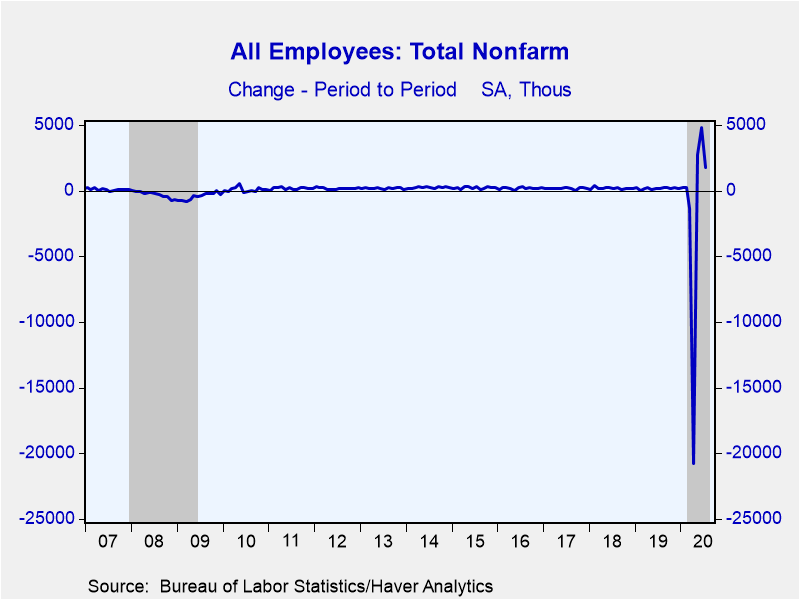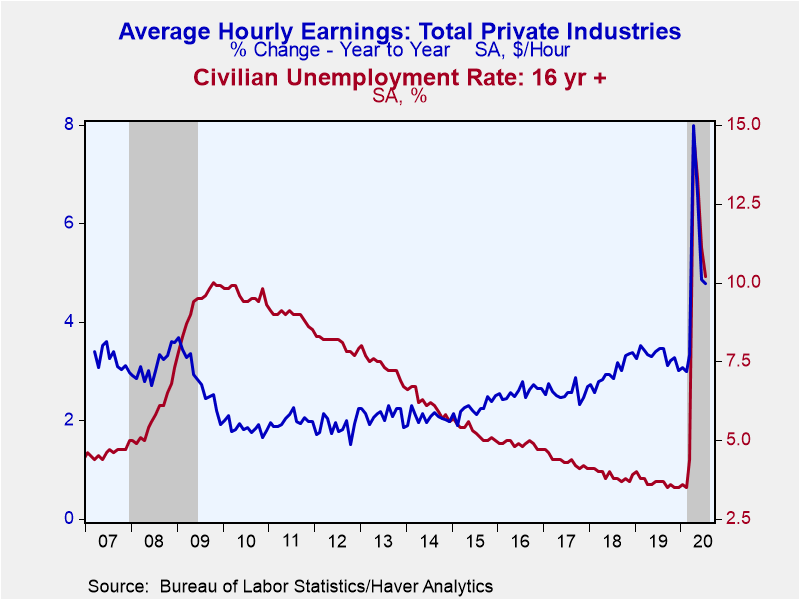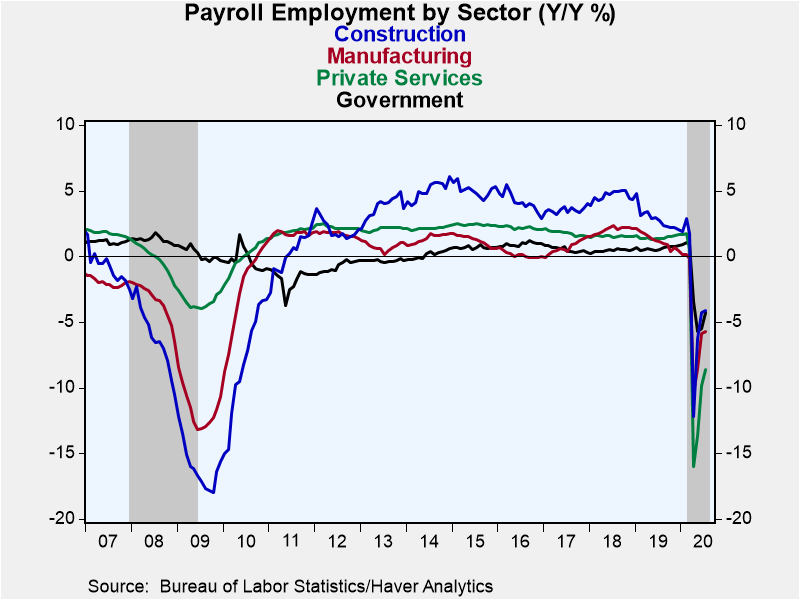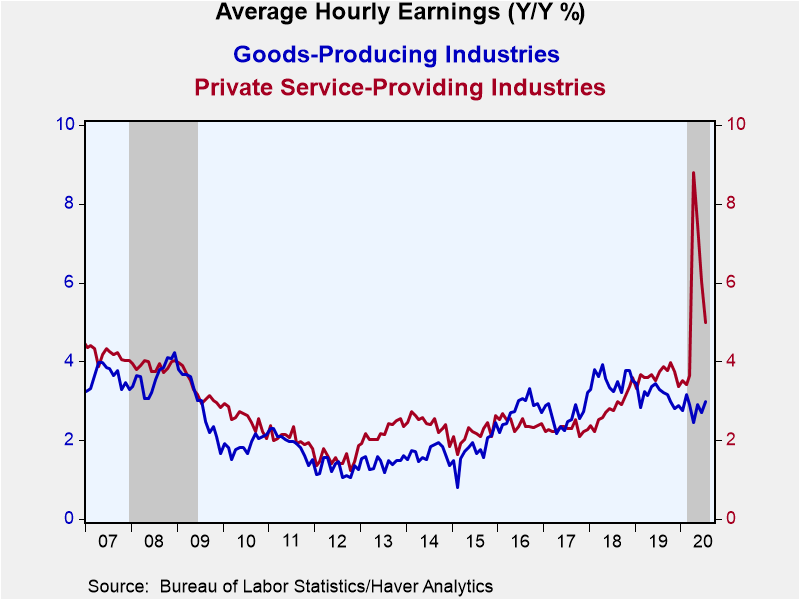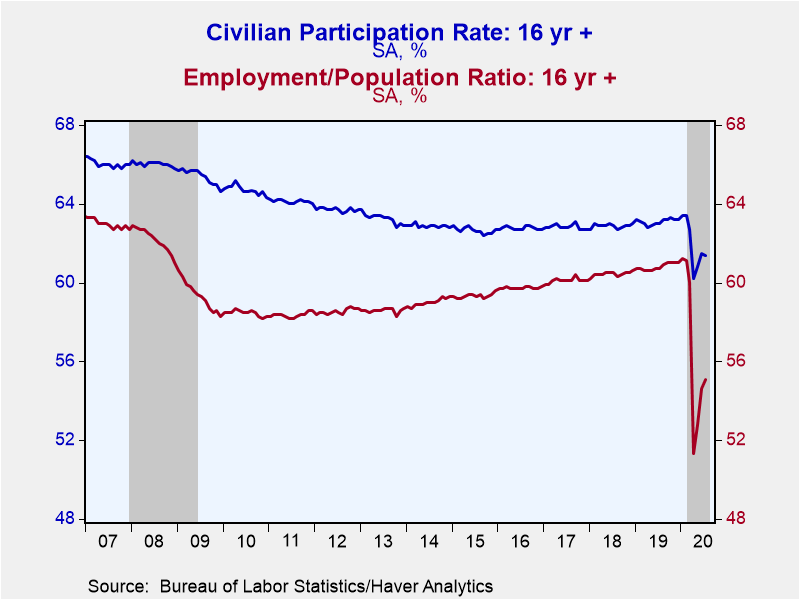 Global| Aug 07 2020
Global| Aug 07 2020U.S. Employment Growth Moderates in July; Earnings Rise Modestly & Jobless Rate Declines
by:Tom Moeller
|in:Economy in Brief
Summary
• Rise in jobs slows after bounce-back from coronavirus outbreak. • Earnings improve modestly. • Unemployment rate declines to four-month low. The labor market continues to improve. Nonfarm payroll employment increased 1.763 million [...]
• Rise in jobs slows after bounce-back from coronavirus outbreak.
• Earnings improve modestly.
• Unemployment rate declines to four-month low.
The labor market continues to improve. Nonfarm payroll employment increased 1.763 million in July (-7.5% y/y) after rising 4.791 million in June, revised from 4.800 million. May employment improved 2.725 million, revised from 2.699 million. These gains followed sharp declines in the prior two months of economic recession. A 1.898 million increase had been expected in the Action Economics Forecast Survey. The estimates amongst 26 forecasters had ranged from 500 to 3,300.
Average hourly earnings improved a modest 0.2% (4.8% y/y) but factory pay strengthened 0.6%. A 0.5% decline had been expected.
The unemployment rate fell to 10.2% from 11.1%. A decline to 10.5% had been expected. Employment in the household survey increased 1.350 million after rising 4.940 million in June while the labor force fell 62,000 after increasing 1.705 million. The overall jobless rate, including those who were marginally attached or working part-time for economic reasons, declined to 16.5% from 18.0%.
From the payroll survey of employment, the 1.763 million jobs increase contained a 26,000 gain (-5.7% y/y) in manufacturing jobs following two outsized increases. Construction payrolls rose 20,000 (-4.1% y/y) but mining & logging employment eased 7,000 (-15.6% y/y).
The number of private service-producing workers increased 1.423 million (-8.6% y/y) as leisure & hospitality hiring rose 592,000 (-24.2% y/y) after a 1.981 million gain. Trade, transportation & utilities employment rose 291,000 (-5.7% y/y) after two larger increases. Retail trade employment improved 258,300 (-5.5% y/y). Education & health services jobs improved 215,000 (-5.1% y/y) following a 567,000 increase. The number of professional & business services jobs rose 170,000 (-6.7% y/y) reflecting a 143,700 (-18.9% y/y) gain in temporary employment. Employment in financial activities rose a steady 21,000 (-1.4% y/y) but the number of information jobs fell 15,000 (-10.4% y/y), the fourth decline in five months.
Government sector employment surged 301,000 (-4.3% y/y). Local government hiring rose 241,000 (6.0% y/y) while the number of state government jobs rose 33,000 (-3.3% y/y. Federal government hiring rose 27,000 (2.9% y/y), all of whom were Census workers.
Average hourly earnings rose 0.2% in July (4.8% y/y) after falling for two straight months. Factory sector earnings rose 0.6% (3.8% y/y) after sharp decline in the two earlier months. Construction sector pay improved a fairly steady 0.3% (3.2% y/y). Amongst private service companies, earnings inched 0.1% higher (5.1% y/y) after two months of sharp decline. Earnings in the information sector strengthened 1.7% (4.4% y/y) but leisure & hospitality pay dropped 0.8% (+1.6% y/y) after two months of even sharper decline. Education & health services earnings rose 0.2% (2.9% y/y) but professional & business service sector pay eased 0.2% (+4.0% y/y), off for the third straight month. Financial sector pay held steady (5.2% y/y) following three straight months of strong gain.
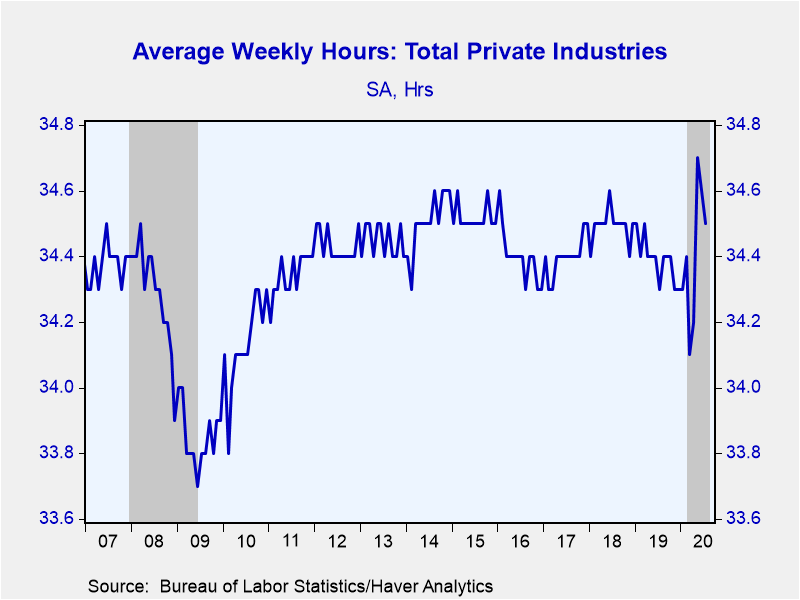 The length of the average workweek eased to 34.5 hours, the
shortest in three months. The private services workweek eased to 33.5 hours
after lengthening to 33.8 from 33.6 in the prior two months. Trade,
transportation & utilities hours fell to 34.0 while information sector hours
eased to 36.3. Leisure & hospitality hours fell to 25.3 but education &
health rose to 33.4. The length of the construction sector workweek held at 38.9
hours for the third straight month, as factory sector surged to 39.7 from a
recession low of 38.0 in April. The length of the mining & logging workweek
rose to 39.7 hours, up from 38.0 three months earlier.
The length of the average workweek eased to 34.5 hours, the
shortest in three months. The private services workweek eased to 33.5 hours
after lengthening to 33.8 from 33.6 in the prior two months. Trade,
transportation & utilities hours fell to 34.0 while information sector hours
eased to 36.3. Leisure & hospitality hours fell to 25.3 but education &
health rose to 33.4. The length of the construction sector workweek held at 38.9
hours for the third straight month, as factory sector surged to 39.7 from a
recession low of 38.0 in April. The length of the mining & logging workweek
rose to 39.7 hours, up from 38.0 three months earlier.
From the household survey, the decline in the unemployment rate to 10.2% occurred as the labor force participation rate slipped marginally m/m to 61.4%, and remained down from 63.4%, just before the recession began. The teenage participation rate eased to 31.7%, a three-month low, but for those aged 20-24, it improved to 67.8%, a four-month high. For workers aged 25-54, the rate eased m/m to 81.3%, up from 79.9% in May. For men aged 25-54, the rate fell to 87.6% and remained down from 89.3% six months earlier. For women of that age, the rate eased to 75.1% and remained well below its February record high of 77%. For workers aged 55 & over, the participation rate improved to 39.2%.
The employment/population ratio for all workers rose to 55.1%, up from 51.3% three months earlier. It remained sharply lower than the recent high of 61.2% in January. The average duration of unemployment rose to 17.9 weeks, up from 6.1 weeks in April.
The teenage unemployment rate fell sharply to 19.3% from 23.2%. It remained below the record 31.9% in April but still much higher than February's 11.0%. The rate for workers aged 20-24 fell to 18.3%, down from the April record of 25.7%. For workers aged 25-54, the rate eased m/m to 9.2%, down from the 12.8% April high. For those over 55, the jobless rate declined to 8.8%, down from the record 13.6% in April.
By educational attainment, unemployment of workers without a high school diploma was 15.4% in July, down from 21.2% in April. High school graduates without any college were 10.8% unemployed last month, down from 17.3% in April but still up from 3.6% in February. Those with some college but no degree were 10.0% unemployed, down sharply from the 15.0% March peak but still up from December's near-record low of 2.7%. College graduates were a 6.7% unemployed, increased from a 1.9% low in February.
The employment & earnings data are collected from surveys taken each month during the week containing the 12th of the month. The labor market data are contained in Haver's USECON database. Detailed figures are in the EMPL and LABOR databases. The expectations figures are in the AS1REPNA database.
Which Workers Have Been Most Affected by the COVID-19 Pandemic? from the Federal Reserve Bank of St. Louis can be found here.
| Employment (SA, M/M Change, 000s) | Jul | Jun | May | Jul Y/Y | 2019 | 2018 | 2017 |
|---|---|---|---|---|---|---|---|
| Payroll Employment | 1,763 | 4,791 | 2,725 | -7.5% | 1.4% | 1.6% | 1.6% |
| Previous Estimate | -- | 4,800 | 2,699 | -- | -- | -- | -- |
| Manufacturing | 26 | 357 | 240 | -5.7 | 1.2 | 2.0 | 0.7 |
| Construction | 20 | 163 | 456 | -4.1 | 2.8 | 4.6 | 3.6 |
| Private Service-Producing | 1,423 | 4,222 | 2,560 | -8.6 | 1.5 | 1.5 | 1.8 |
| Government | 301 | 54 | -511 | -4.3 | 0.6 | 0.5 | 0.4 |
| Average Weekly Hours - Private Sector | 34.5 | 34.6 | 34.7 | 34.3 | 34.4 | 34.5 | 34.4 |
| Private Sector Average Hourly Earnings (%) | 0.2 | -1.3 | -1.1 | 4.8 | 3.3 | 3.0 | 2.6 |
| Unemployment Rate (%) | 10.2 | 11.1 | 13.3 | 3.7 | 3.7 | 3.9 | 4.3 |
Tom Moeller
AuthorMore in Author Profile »Prior to joining Haver Analytics in 2000, Mr. Moeller worked as the Economist at Chancellor Capital Management from 1985 to 1999. There, he developed comprehensive economic forecasts and interpreted economic data for equity and fixed income portfolio managers. Also at Chancellor, Mr. Moeller worked as an equity analyst and was responsible for researching and rating companies in the economically sensitive automobile and housing industries for investment in Chancellor’s equity portfolio. Prior to joining Chancellor, Mr. Moeller was an Economist at Citibank from 1979 to 1984. He also analyzed pricing behavior in the metals industry for the Council on Wage and Price Stability in Washington, D.C. In 1999, Mr. Moeller received the award for most accurate forecast from the Forecasters' Club of New York. From 1990 to 1992 he was President of the New York Association for Business Economists. Mr. Moeller earned an M.B.A. in Finance from Fordham University, where he graduated in 1987. He holds a Bachelor of Arts in Economics from George Washington University.


